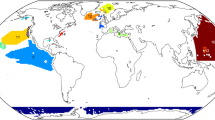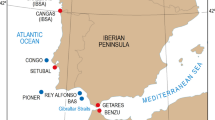Abstract
IN the southern hemisphere, female and young male sperm whales (up to about 39 feet long) are not normally found in higher latitudes than 40° S while large males occur in Antarctic waters1–3; clearly many large bulls must migrate from the breeding areas into colder regions. Evidence of the return of large bulls to lower latitudes rests upon marking them in the Antarctic4 or external infestation by Antarctic Cocconeis or Cyamus5. Only a single mark5 has been recovered which provides direct evidence for the return north from Antarctic waters. This mark (USSR No. 650203) was fired on December 25, 1967, at 62° 22′ S 26° 25′ E and the whale was killed on May 13, 1968, off Durban. The small size of the male concerned (35 feet at death) makes this record rather surprising although Jonsgård6 did mention that the smallest whales from Antarctic waters were about 35 feet. Marking can provide information on only a small part of the whale population at considerable cost, freshness of the whale restricts the value of infestation as an indicator but the study of food remnants in sperm whale stomachs provides another method without these disadvantages.
This is a preview of subscription content, access via your institution
Access options
Subscribe to this journal
Receive 51 print issues and online access
$199.00 per year
only $3.90 per issue
Buy this article
- Purchase on Springer Link
- Instant access to full article PDF
Prices may be subject to local taxes which are calculated during checkout
Similar content being viewed by others
References
Townsend, C. H., Zoologica, New York, 19, 1 (1935).
Matthews, L. H., The Sperm Whale, Physeter catodon. Discovery Rep., 17, 93 (1938).
Slijper, E. J., Utrecht, W. L. Van, and Naaktgeboren, C., Bijdr. Dierk., Afl., 34, 1 (1964).
Brown, S. G., Rep. Intern. Commun. Whal., 21, 51 (1971).
Best, P. B., Investl. Rep. Div. Sea Fish. S. Afr., 78, 1 (1969).
Jonsgård, A., Norsk Hvalfangsttid, 49, 289 (1960).
Clarke, M. R., Norsk Hvalfangsttid, 51, 173 (1962).
Clarke, M. R., Discovery Rep. (in the press).
Clarke, M. R., Bull. Brit. Mus. Nat. Hist., 8, 419 (1962).
Deacon, G. E. R., Discovery Rep., 15, 1 (1937).
Mackintosh, N. A., Proc. Roy. Soc., B, 152, 624 (1960).
Gambell, R., Norsk Hvalfangsttid, 57, 126 (1968).
Best, P. B., Invest. Rep. Div. Sea Fish S. Afr., 66, 1 (1968).
Author information
Authors and Affiliations
Rights and permissions
About this article
Cite this article
CLARKE, M. New Technique for the Study of Sperm Whale Migration. Nature 238, 405–406 (1972). https://doi.org/10.1038/238405a0
Received:
Issue Date:
DOI: https://doi.org/10.1038/238405a0
This article is cited by
-
?Mastigoteuthis B Clarke, 1980, is a junior synonym of Asperoteuthis acanthoderma (Lu, 1977) (Cephalopoda, Oegopsida, Chiroteuthidae), a rare cosmopolitan deep-sea squid
Marine Biodiversity (2021)
-
A review of Southern Ocean squids using nets and beaks
Marine Biodiversity (2020)
-
Cephalopod remains from the stomach of a sperm whale stranded at Rio Grande do Sul in Brazil
Marine Biology (1980)
Comments
By submitting a comment you agree to abide by our Terms and Community Guidelines. If you find something abusive or that does not comply with our terms or guidelines please flag it as inappropriate.



